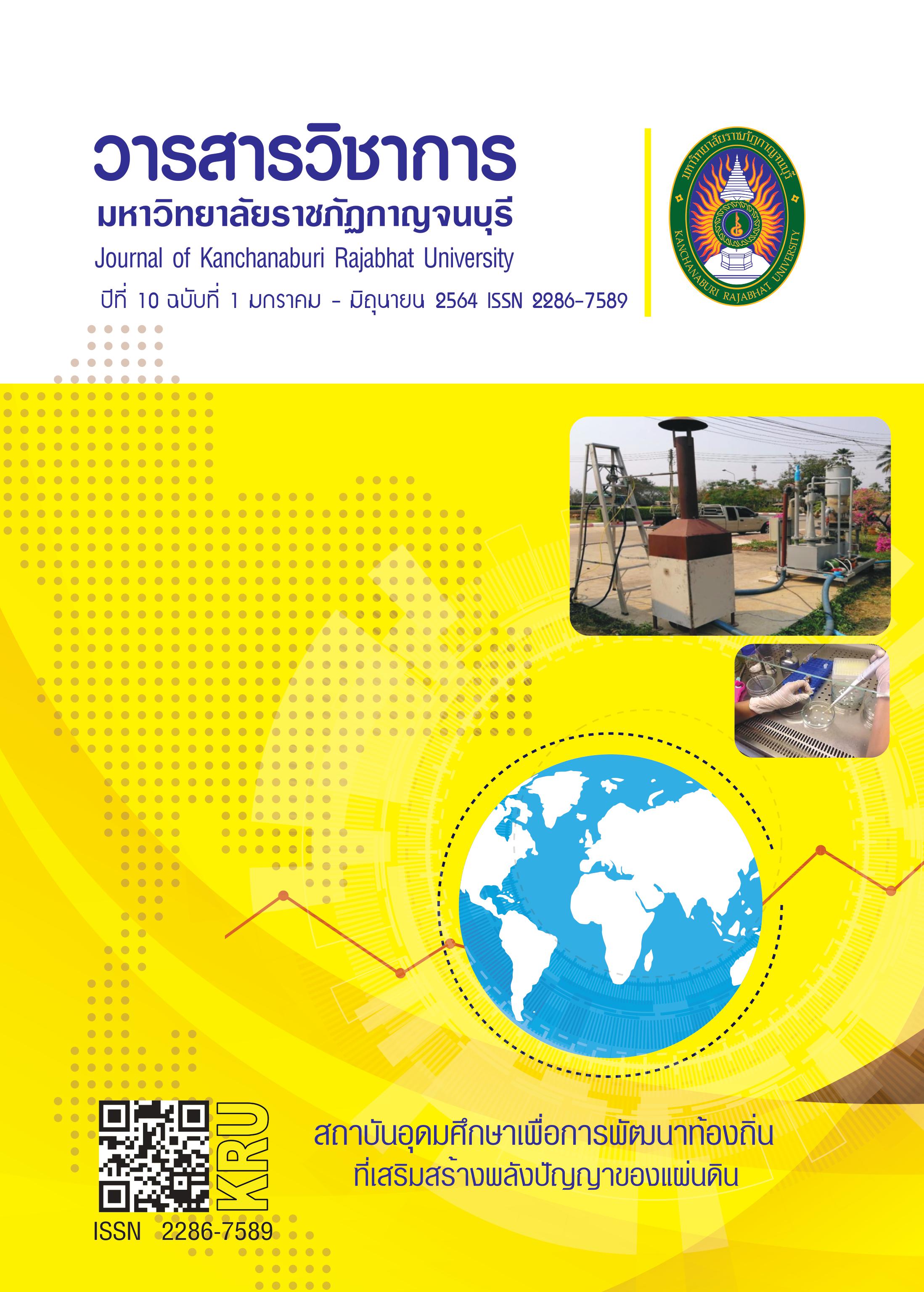ฤทธิ์การต้านเชื้อจุลชีพของสารสกัดจากตะคึก
Main Article Content
บทคัดย่อ
การวิจัยครั้งนี้มีวัตถุประสงค์ เพื่อศึกษาเทคนิคการสกัดสารและฤทธิ์การต้านจุลชีพของสารสกัดหยาบ ของตะคึก ด้วยชิ้นส่วนเปลือกและราก โดยใช้วิธีการสกัดสารด้วยตัวทำละลาย เฮกเซน ไดคลอโรมีเทน เอทิลอะซิเตท และเมทานอล นำสารสกัดหยาบที่ได้ทดสอบฤทธิ์การต้านเชื้อโดยวิธี Agar disc-diffusion method กับเชื้อจุลชีพ 9 ชนิด ได้แก่ Staphylococcus aureus, Bacillus cereus, Bacillus thuringiensis, Escherichia coli, Enterobacter aerogenes, Salmonella typhimurium , Aspergillus niger, Candida albicans และSaccharomyces cerevisiae วัดระดับฤทธิ์การต้านจากเส้นผ่านศูนย์กลางของขนาดวงใสในอาหารเลี้ยงเชื้อทดสอบ พบว่า ผลผลิตร้อยละ (% yield) จากเปลือกมีค่ามากกว่ารากในทุกตัวทำละลาย ระดับความเข้มข้นของสารสกัดที่เหมาะสมในการทดสอบฤทธิ์ต้านทานเชื้อจุลชีพอยู่ที่ความเข้มข้นร้อยละ 0.1 โดยมวลต่อปริมาตร สารสกัดหยาบจากเปลือกและรากของตะคึกที่สกัดด้วยเอทิล อะซิเตท มีฤทธิ์ในการต้านเชื้อแบคทีเรียแกรมบวกมากที่สุด โดยแบ่งเป็น สารสกัดหยาบจากเปลือกมีฤทธิ์การต้าน Staphylococcus aureus ดีที่สุดที่ระดับ 11.08 มิลลิเมตร สารสกัดหยาบจากราก มีฤทธิ์ในการต้าน Bacillus cereus ดีที่สุดที่ระดับ 12.66 มิลลิเมตร ในกลุ่มแบคทีเรียแกรมลบสารสกัดหยาบจากรากมีฤทธิ์ต้าน Escherichia coli ดีที่สุดในระดับ 10.00 มิลลิเมตร แต่ไม่พบการต้านแบคทีเรียแกรมลบในสารสกัดหยาบจากเปลือกสารสกัดหยาบด้วยเฮกเซน มีฤทธิ์การต้านเชื้อราดีที่สุด โดยสามารถต้าน Saccharomyces cerevisiae ดีที่สุด สารสกัดหยาบจากเปลือกมีฤทธิ์การต้านที่ระดับ 8.30 มิลลิเมตร สารสกัดหยาบจากรากมีฤทธิ์การต้านที่ระดับ 10.80 มิลลิเมตร ดังนั้นตะคึกสามารถสกัดได้ด้วยวิธีการสกัดด้วยตัวทำละลายและสารสกัดที่ได้จากตะคึกมีฤทธิ์ในการต้านเชื้อจุลชีพ โดยสารสกัดหยาบจากรากมีฤทธิ์การต้านจุลชีพ ดีกว่าสารสกัดหยาบจากเปลือกของตะคึก
Article Details
เอกสารอ้างอิง
เฉลียว เพชรทอง. (2552). การศึกษาสารด้านเชื้อจุลชีพของสารสกัดจากพืชสมุนไพรในจังหวัดกาญจนบุรี.
ค้นเมื่อสิงหาคม 6, 2559. จาก http://rir.nrct.go.th/.
ชลิดา อนุพันธ์. (2558). ฤทธิ์ต้านเชื้อจุลชีพของสารสกัดจากมะสัง. ค้นเมื่อ สิงหาคม 6, 2559.
จาก http://ethesis.kru.ac.th/files/V59_66/Charida%20%20Anupan.pdf.
ฐานข้อมูลพรรณไม้ องค์กรสวนพฤกษศาสตร์. (2559). ตะคึก. ค้นเมื่อ สิงหาคม 6, 2559.
จาก http://www.qsbg.org/Database/plantdb/.
ณัฐกานต์ วงศ์สีสม, จามจุรี จินะตา, บุษบา มะโนแสน, จิรรัชต์ กันทะขู้, สุรีพร วันควร และ สุภวดี ศรีแย้ม. (2557).
การศึกษาฤทธิ์ต้านแบคทีเรียก่อโรคในอาหารของน้ำมันหอมระเหยจากมะแขว่น. วารสารวิจัยและพัฒนา
มจธ, 37(1), 3-15.
ณัฐา พัฒนากุล. (2554). ศึกษาวิเคราะห์และทบทวนข้อกำหนดยีสต์และราในอาหาร. ค้นเมื่อ สิงหาคม 20, 2559.
จาก http://iodinethailand.fda.moph.go.th/kmfood/file/339.pdf.
ธีระพงษ์ ขันทเจริญ อรพิน เกิดชูชื่น และ ณัฎฐา เลาหกุลจิตต์. (2553). ประสิทธิภาพการเป็นสารต้านอนุมูลอิสระ
จากสารสกัดเปลือกและเมล็ดขององุ่นพันธุ์คาร์ดินัล. วารสารวิทยาศาสตร์เกษตร, 41 (3/1), 617-620.
ธีรเดช ชีวนันทชัย และ อดิรักษ์ กาญจนหฤทัย. (2548). การจําลองแบบและการทดลองของการกลั่นน้ำมันหอม
ระเหยจากผิวมะกรูด. เอกสารการประชุมวิชาการเครือข่ายวิศวกรรมเครื่องกลแห่งประเทศไทย
ครั้งที่ 19. ภูเก็ต.
พีรพงษ์ พึ่งแย้ม. (2558). การเตรียมสารสกัดหยาบจากพืชป่าชายเลนและฤทธิ์ยับยั้งแบคทีเรียก่อโรค. วารสาร
มหาวิทยาลัยราชภัฏภูเก็ต. ค้นเมื่อ สิงหาคม 15, 2559. จาก http://academic-paper.pkru.ac.th/
_FH2BC69.pdf.
วีระชัย ณ นคร. (2544). สวนพฤกษศาสตร์สมเด็จพระนางเจ้าสิริกิติ์. เล่ม 5 พิมพ์ครั้งที่ 1. กรุงเทพมหานคร:
โอ.เอส. พริ้นติ้ง เฮาส์.
สุนันทา ข้องสาย และ ชาคริยา ฉลาด. (2558). ฤทธิ์ต้านแบคทีเรียของสารสกัดจากปรงทะเลที่พบบริเวณ
มหาวิทยาลัยเทคโนโลยีราชมงคลศรีวิชัย วิทยาเขตตรัง. วารสารวิชาการและวิจัย มทร.พระนคร,
ฉบับพิเศษ, 363-368.
สำนักงานวัฒนธรรม จังหวัดกาญจนบุรี. (2557). คุณค่าโภชนาการของตะคึก. ค้นเมื่อ สิงหาคม 6, 2559.
จาก http://pr.prd.go.th/kanchanaburi/ewt_news.php?nid=576&filename=index.
สำนักส่งเสริมพัฒนาวิทยาศาสตร์และเทคโนโลยีแห่งชาติ. (2557). จุลชีพ. ค้นเมื่อ สิงหาคม 16, 2559.
จาก http://www.nstda.or.th/nstda-r-and-d/17065-bacteria-yeast.
ศรัญญา พรศักดา, มาระตรี เปลี่ยนศิริชัย, กิตติ ศรีสะอาด, มัณฑนา นครเรียบ, ประชุมพร เลาห์ประเสริฐ,
ทวีรัตน์ วิจิตร สุนทรกุล และทรงศิลป์ พจน์ชนะชัย. (2553). ผลของสารสกัดจากมะเขือพวงในการยับยั้ง
แบคทีเรียก่อโรค Escherichia coli, Staphylococcus aureus และ Salmonella typhimurium.
วารสารวิทยาศาสตร์เกษตร, 41(3/1), 573-576.
อรอนงค์ รัชตราเชนชัย. ความรู้ทั่วไปเกี่ยวกับเชื้อพาหะนำโรค. ศูนย์ข้อมูลโรคติดต่อและพาหะนำโรค. ค้นเมื่อ
สิงหาคม 15, 2559, จาก http://webdb.dmsc.moph.go.th.


